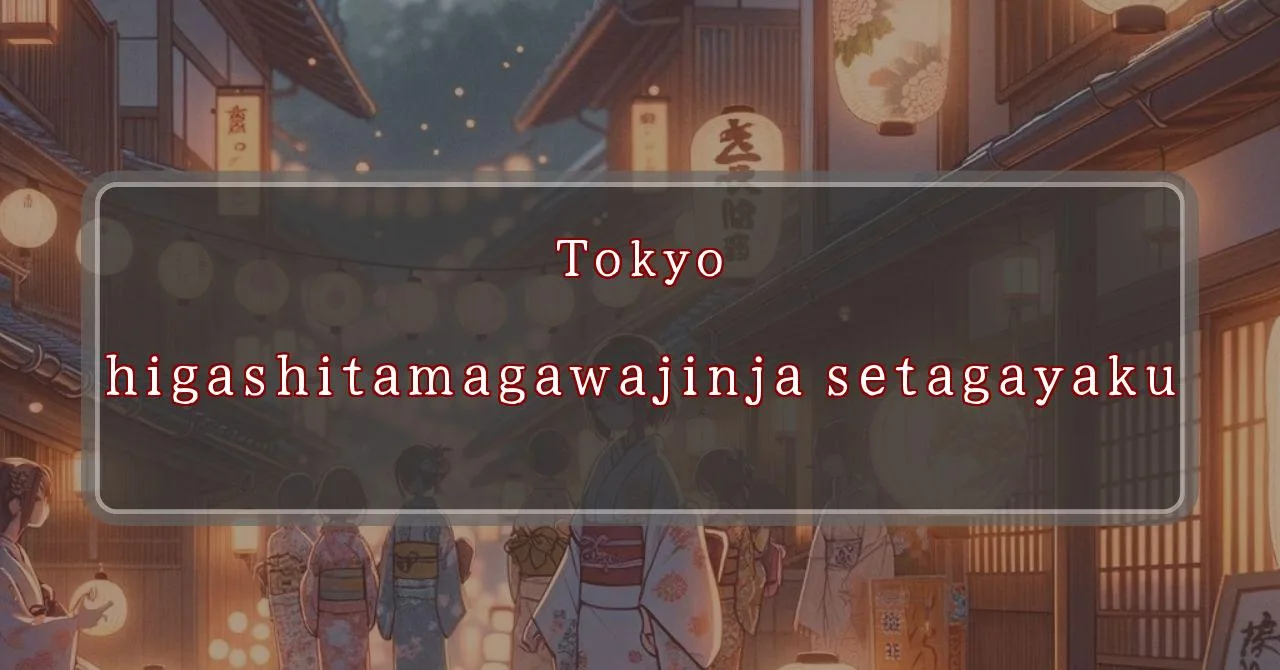Gleaming lights, vibrant festival
Basic Information
Higashi Tamagawa Jinja Shrine is a Shinto shrine located in Setagaya Ward, Tokyo, Japan. It is dedicated to the deities Take-mina-kata-no-kami and Ōyamazumi-no-kami.
- Address: 1-32-9 Higashi Tamagawa, Setagaya-ku, Tokyo 158-0084, Japan
- Phone Number: 03-3720-0007
- Access: 13-minute walk from Den-en-chofu Station on the Tokyu Toyoko Line, 11-minute walk from Okusawa Station on the Tokyu Meguro Line, or 11-minute walk from Yukigaya-Otsuka Station on the Tokyu Ikegami Line
- Festival Days: Third Sunday of August
Main Events and Attractions of the Festival
The Higashi Tamagawa Jinja Shrine Festival is a lively and colorful event that attracts many visitors each year. The main events and attractions of the festival include:
Mikoshi Procession
One of the highlights of the festival is the mikoshi procession. A mikoshi is a portable shrine that is carried through the streets by a team of people. The mikoshi of Higashi Tamagawa Jinja Shrine is particularly large and impressive, and it is carried by a team of over 100 people. The procession is accompanied by music and dancing, and it creates a festive atmosphere in the streets.
Kagura Performance
Kagura is a traditional Japanese performing art that is often performed at Shinto shrines. During the Higashi Tamagawa Jinja Shrine Festival, kagura performances are held several times a day. The performances tell stories from Japanese mythology and folklore, and they are accompanied by music and dance. Kagura is a beautiful and fascinating art form, and it is a great way to learn more about Japanese culture.
Bon Odori Dance
Bon Odori is a traditional Japanese folk dance that is performed during the Obon festival. Obon is a time when Japanese people remember and honor their ancestors. During the Higashi Tamagawa Jinja Shrine Festival, Bon Odori dances are held in the evening. Anyone can participate in the Bon Odori dance, and it is a great way to experience Japanese culture and have some fun.
Food Stalls
No Japanese festival is complete without food stalls! At the Higashi Tamagawa Jinja Shrine Festival, there are many food stalls selling a variety of delicious Japanese foods. Some of the most popular foods include yakitori (grilled chicken skewers), takoyaki (octopus balls), and kakigori (shaved ice with syrup). There are also many stalls selling souvenirs and crafts.
Blessings and Deities
Higashi Tamagawa Jinja Shrine is dedicated to the deities Take-mina-kata-no-kami and Ōyamazumi-no-kami. Take-mina-kata-no-kami is the god of water and agriculture, while Ōyamazumi-no-kami is the god of mountains and forests. These deities are said to bring blessings of good harvest, prosperity, and protection from natural disasters.
- Take-mina-kata-no-kami: God of water and agriculture
- Ōyamazumi-no-kami: God of mountains and forests
- Blessings: Good harvest, prosperity, protection from natural disasters
Origin and History
The origins of Higashi Tamagawa Jinja Shrine are unclear, but it is believed to have been founded in the Edo period (1603-1868). The shrine was originally located in a different part of Setagaya Ward, but it was moved to its current location in 1939. The shrine building is a registered tangible cultural property of Setagaya Ward.
- Founded: Edo period (1603-1868)
- Original location: Different part of Setagaya Ward
- Current location: 1-32-9 Higashi Tamagawa, Setagaya-ku, Tokyo 158-0084, Japan
- Registered tangible cultural property: Setagaya Ward
Tips and Notes for Visitors
Here are some tips and notes for visitors to the Higashi Tamagawa Jinja Shrine Festival:
- Wear comfortable shoes: You will be doing a lot of walking, so make sure to wear comfortable shoes.
- Bring a camera: There will be many photo opportunities at the festival, so bring a camera to capture the memories.
- Arrive early: The festival gets crowded, so it is best to arrive early to avoid the crowds.
- Be respectful: The festival is a religious event, so be respectful of the shrine and its customs.
Parking Information
There is no parking lot at Higashi Tamagawa Jinja Shrine. However, there are several coin-operated parking lots in the area. You can also use public transportation to get to the shrine. The nearest station is Den-en-chofu Station on the Tokyu Toyoko Line.
- Parking lot: None
- Coin-operated parking lots: Available in the area
- Public transportation: Den-en-chofu Station on the Tokyu Toyoko Line
Popular Stalls and Food Carts in Recent Years
| Type of Stall | Description |
|---|---|
| Takoyaki | A staple at Japanese festivals. Characterized by a crispy outside and a creamy inside. |
| Jaga Butter | A simple yet popular snack of hot potatoes lavishly topped with melted butter. |
| Baby Castella | Small castella cakes, sweet and fluffy treats enjoyed by children and adults alike. |
| Grilled Ayu with Salt | Fresh ayu fish grilled whole with salt, a savory taste of Japanese summer. |
| Shaapin | A unique gourmet item influenced by foreign cuisine, with a chewy skin wrapping the filling. |
| Okonomiyaki | A Japanese grilled dish where you often choose your own ingredients for a personalized flavor. |
| Cotton Candy | A fluffy, sweet snack that’s extremely popular with children. |
| Chocolate Banana | A banana coated in chocolate, a fun and visually appealing dessert. |
| Kushiyaki | Various types of ingredients skewered and grilled, an easy-to-enjoy snack. |
| Yakisoba | Fried noodles mixed with a special sauce, a fast food favorite in Japan. |



